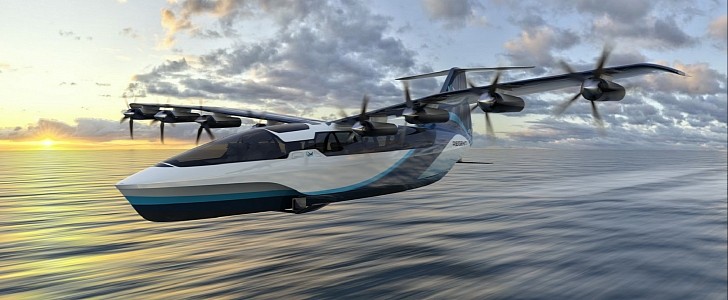Boston-based seaglider developer Regent Craft announced recently that it adopted Siemens’ portfolio of software and services to speed up the production of its all-electric flying vessel. The part aircraft, part boat vehicle aims to provide a cleaner and more affordable transportation solution for coastal communities worldwide.
Boasting a design that allows it to float, foil, and fly, Regent’s seaglider has drawn a lot of attention since its big unveiling last spring. This all-electric flying vessel will be able to transport both passengers and cargo over long distances while also cutting operating costs in the process. And Siemens’ Xcelerator portfolio of cloud-based software and services is the fundamental design, engineering, and development platform for the highly-awaited seaglider.
According to the recent announcement from the German tech giant and the U.S.-based manufacturer, Siemens’ platform is crucial now that the seaglider is getting closer and closer to certification and full-scale commercial production. The Siemens Xcelerator as a Service proves to be very beneficial for the Boston-based startup, allowing it to stay 100 percent focused on the important aspects such as design, engineering, manufacturing, and innovation, as explained by Mike Klinker, Regent cofounder and CTO.
Regent’s revolutionary seaglider operates over the water as an electric WIG (wing-in-ground-effect) vehicle. It floats on its hull near the dock and it foils on its hydrofoils at up to 40 knots (46 mph/74 kph) when it comes in and out of the port, to ensure a higher degree of comfort for its passengers. Once it hits open water, it switches to high-speed flying, being able to hit a top speed of 160 knots (184 mph/296 kph).
Regent’s flagship seaglider is Viceroy, which will have a capacity of 12 passengers and will cover routes of up to 180 miles (290 km) with existing battery technology. However, Regent is confident that the range will increase significantly to up to 500 miles (804 km) with next-gen batteries while still using the existing dock infrastructure.
Engineered to serve coastal communities all over the world, Regent’s new category of vehicles will be able to transport both passengers and critical cargo at lower costs and high speeds, with the seaglider also promising zero emissions thanks to its 100 percent electric propulsion system.
Regent hopes for its seagliders to enter service in 2025. You can get a better idea of how this flying boat looks in the video below.
According to the recent announcement from the German tech giant and the U.S.-based manufacturer, Siemens’ platform is crucial now that the seaglider is getting closer and closer to certification and full-scale commercial production. The Siemens Xcelerator as a Service proves to be very beneficial for the Boston-based startup, allowing it to stay 100 percent focused on the important aspects such as design, engineering, manufacturing, and innovation, as explained by Mike Klinker, Regent cofounder and CTO.
Regent’s revolutionary seaglider operates over the water as an electric WIG (wing-in-ground-effect) vehicle. It floats on its hull near the dock and it foils on its hydrofoils at up to 40 knots (46 mph/74 kph) when it comes in and out of the port, to ensure a higher degree of comfort for its passengers. Once it hits open water, it switches to high-speed flying, being able to hit a top speed of 160 knots (184 mph/296 kph).
Regent’s flagship seaglider is Viceroy, which will have a capacity of 12 passengers and will cover routes of up to 180 miles (290 km) with existing battery technology. However, Regent is confident that the range will increase significantly to up to 500 miles (804 km) with next-gen batteries while still using the existing dock infrastructure.
Engineered to serve coastal communities all over the world, Regent’s new category of vehicles will be able to transport both passengers and critical cargo at lower costs and high speeds, with the seaglider also promising zero emissions thanks to its 100 percent electric propulsion system.
Regent hopes for its seagliders to enter service in 2025. You can get a better idea of how this flying boat looks in the video below.






